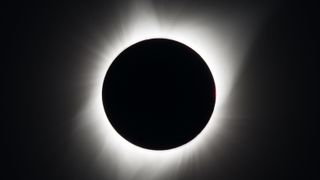
Stefanie Waldek
Space.com contributing writer Stefanie Waldek is a self-taught space nerd and aviation geek who is passionate about all things spaceflight and astronomy. With a background in travel and design journalism, as well as a Bachelor of Arts degree from New York University, she specializes in the budding space tourism industry and Earth-based astrotourism. In her free time, you can find her watching rocket launches or looking up at the stars, wondering what is out there. Learn more about her work at www.stefaniewaldek.com.
Latest articles by Stefanie Waldek

Watch 2 gorgeous supernova remnants evolve over 20 years (timelapse video)
By Stefanie Waldek published
These supernova remnants are moving at extraordinary speeds only visible to us in long-term timelapses.

Mars' subsurface is 'burping' out methane and scientists aren't sure why
By Stefanie Waldek published
A new theory suggests that NASA's Curiosity rover could be "burping" the surface of the Red Planet, releasing methane trapped beneath a salty crust.

When is the next total solar eclipse in the US?
By Stefanie Waldek published
The next total solar eclipse to hit the United States will be in 2033, but it will only be visible in Alaska. The Lower 48 won't get one until 2044.

Peer inside remnants of an 800-year-old supernova and see a 'zombie' star
By Stefanie Waldek published
NASA's Chandra X-ray Observatory images the firework-like remnants of the great supernova of 1181.

NASA will launch rockets into the total solar eclipse on April 8
By Stefanie Waldek published
It's round two for the Atmospheric Perturbations around Eclipse Path (APEP) sounding rockets.

There's an April Fools' Day prank about the 2024 solar eclipse — don't fall for it
By Stefanie Waldek published
No, the date and path of the total solar eclipse have not been miscalculated.

'Them space drugs cooked real good:' Varda Space just made an HIV medicine in Earth orbit
By Stefanie Waldek published
Varda Space has written up the results of its groundbreaking W-1 mission, which successfully crystalized the metastable Form III of the antiviral drug ritonavir in space and returned it to Earth.

Northern lights (aurora borealis): What they are & how to see them
By Stefanie Waldek, Daisy Dobrijevic last updated
Reference Discover everything there is to know about the northern lights, including how they form, where they can be seen and what causes their colors.

JAXA, NASA reveal 1st images from XRISM X-ray space telescope
By Stefanie Waldek published
Launched in September 2023, the X-ray Imaging and Spectroscopy Mission (XRISM) — led by JAXA, in collaboration with NASA with additional contributions from ESA — has produced its first test images.

Aftermath of 2 star explosions captured in breathtaking new NASA image
By Stefanie Waldek published
Supernova remnant 30 Doradus B, or 30 Dor B, is the (former) star of this new image.

NASA's Perseverance rover captures 360-degree view of Mars' Jezero Crater (video)
By Stefanie Waldek published
Get a detailed look at Perseverance's current location on Mars — the ancient Jezero Crater.

New Hubble Telescope image shows mysterious spokes on Saturn's rings
By Stefanie Waldek published
Scientists have no idea what the spokes are.

Hubble Telescope gifts us a dazzling starry 'snow globe' just in time for the holidays
By Stefanie Waldek published
The snow globe–esque image was created with Hubble data from 2006 to 2021.

This Antarctic glacier dramatically retreated. Then, its ice shelf totally collapsed (satellite image)
By Stefanie Waldek published
This might indicate a "glaciological tipping point" on the Antarctic Peninsula, an important consideration as global warming continues to affect ocean temperatures.

Europe's JUICE probe will be 1st to use gravity of Earth and moon to slingshot to Jupiter
By Stefanie Waldek published
The spacecraft recently burned 10 percent of its total fuel in a single 43-minute maneuver as preparation for the double gravity assist.

Mars probe sees Red Planet atmosphere glowing green at night
By Stefanie Waldek published
Using ESA's ExoMars Trace Gas Orbiter, scientists have observed nightglow in Mars' atmosphere, a phenomenon where the night sky glows green, almost like an aurora.

Satellite data and 100-year-old images reveal quickening retreat of Greenland's glaciers
By Stefanie Waldek published
Thanks to century-old photos taken by Danish pilots, we can study long-term changes in Greenland's glaciers.

What is STEVE, and how is it different from the aurora?
By Stefanie Waldek published
Reference STEVE is an atmospheric phenomenon that is similar to yet separate from the aurora. It looks like a mauve streak across the night sky.

The West Antarctic Ice Sheet is melting, and it's too late to stop it
By Stefanie Waldek published
A best-case projection that meets ambitious Paris Accord targets suggests the West Antarctic Ice Sheet will melt three times faster in the 21st century than it did in the 20th.

1st-ever radio images of an annular solar eclipse showcase the sun's extended corona
By Stefanie Waldek published
Scientists used the new Owens Valley Radio Observatory Long Wavelength Array (OVRO-LWA) in California to capture radio images of October's annular eclipse.

What are different types of clouds and how do they form?
By Stefanie Waldek published
There are 10 primary types of clouds on Earth. Here you can learn about what they're made of, how they form and how they are classified.

Severe space weather is messing up bird migrations, new study suggests
By Stefanie Waldek published
New research indicates that the number of migrating birds decreases during severe space weather events. They are also more prone to becoming lost.

Mercury was shrinking for at least 3 billion years — and it still might be today
By Stefanie Waldek published
New research indicates that Mercury's thermal contraction was still occurring as recently as 300 million years ago.

The ozone hole above Antarctica has grown to three times the size of Brazil
By Stefanie Waldek published
Observations from ESA's Copernicus Sentinel-5P satellite indicate the ozone hole above Antarctica is one of the largest seasonal holes ever observed.

NASA will launch rockets into the annular solar eclipse's shadow on Oct. 14
By Stefanie Waldek published
A NASA mission called APEP will launch three sounding rockets into the annular solar eclipse to measure changes in electric and magnetic fields, density, and temperature of the ionosphere.
